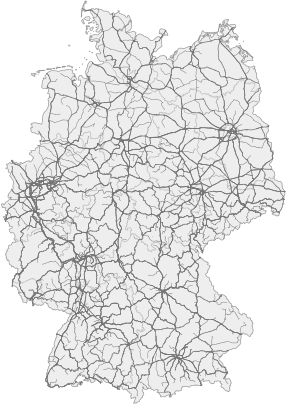
Back Ferrocarril en Alemania Spanish Transport ferroviaire en Allemagne French Németország vasúti közlekedése Hungarian ドイツの鉄道 Japanese Jernbane i Tyskland NB Transport kolejowy w Niemczech Polish Transportul feroviar în Germania Romanian Железнодорожный транспорт в Германии Russian Järnväg i Tyskland Swedish การขนส่งระบบรางในประเทศเยอรมนี Thai
| Rail network of Germany | |||||
|---|---|---|---|---|---|
 | |||||
| Operation | |||||
| National railway | Deutsche Bahn | ||||
| Major operators | Transdev Germany Netinera | ||||
| Statistics | |||||
| Ridership | 2.87 billion (2018)[1] | ||||
| Passenger km | 97.8 billion (2018)[1] | ||||
| Freight | 116 billion tkm (2018)[1] | ||||
| System length | |||||
| Total | 33,399 km (20,753 mi) (2022, Deutsche Bahn only)[2] | ||||
| Double track | 18,556 km (11,530 mi) (2022, Deutsche Bahn only)[2] | ||||
| Electrified | 20,540 km (12,760 mi) (2022, Deutsche Bahn only)[2] | ||||
| High-speed | 1,658 km (1,030 mi)[3] | ||||
| Track gauge | |||||
| Main | 1,435 mm / 4 ft 8+1⁄2 in standard gauge | ||||
| High-speed | standard gauge | ||||
| Electrification | |||||
| Main | 15 kV 16.7 Hz | ||||
| 750 V DC | Berlin S-Bahn | ||||
| 1,200 V DC | Hamburg S-Bahn | ||||
| Features | |||||
| No. tunnels | 1,079[4] | ||||
| Tunnel length | 168,121 m (551,578 ft)[4] | ||||
| |||||
Rail transport in Germany is provided predominantly by Deutsche Bahn (DB, lit. 'German Railway'). As of 2021[update], the railway network in Germany (DB only) had a length of 33,399 km (20,753 mi), of which 20,540 km (12,760 mi) were electrified and 18,556 km (11,530 mi) were double track.[2] About 1,658 km (1,030 mi) are high-speed railway lines.[3] Germany has the 6th longest railway network in the world, and the largest in Europe after Russia.[5]
Germany was ranked 4th among national European rail systems in the 2017 European Railway Performance Index assessing intensity of use, quality of service and safety.[6] It had a very good rating for intensity of use, by both passengers and freight, and good ratings for quality of service and safety.[6] It also captured relatively high value in return for public investment with cost to performance ratios that outperform the average ratio for all European countries.[6]
Germany's rail freight of 117 billion tons/kilometer meant it carried 17.6% of all inland German cargo in 2015.[7]
Germany is a member of the International Union of Railways (UIC). The UIC Country Code for Germany is 80.
Urban rail in Germany includes rapid transit (known as U-Bahn), commuter rail (known as S-Bahn), Stadtbahn (light rail), trams and funiculars (e.g. in Dresden). Suspension railways (Schwebebahn) are present in two cities, Dresden and Wuppertal, in addition to the H-Bahn at Düsseldorf Airport and Dortmund University. Stuttgart has an urban rack railway.
- ^ a b c Cite error: The named reference
destatis8/2was invoked but never defined (see the help page). - ^ a b c d "Railway Statistics 2022 Report" (PDF).
- ^ a b "Europe's High-Speed Rail Leaders". The Globalist. 8 September 2018. Retrieved 5 October 2023.
- ^ a b "Statistik der Eisenbahn-Tunnel in Deutschland" (in German). Retrieved 10 December 2024.
- ^ "Length of railroad network in selected countries around the world in 2021". Statista. 2021. Retrieved 15 December 2024.
- ^ a b c "the 2017 European Railway Performance Index". Boston Consulting Group. 8 January 2021.
- ^ "Is the German Rail Freight System broken? A portrait of DB Cargo | Combined Transport". 4 September 2017.
